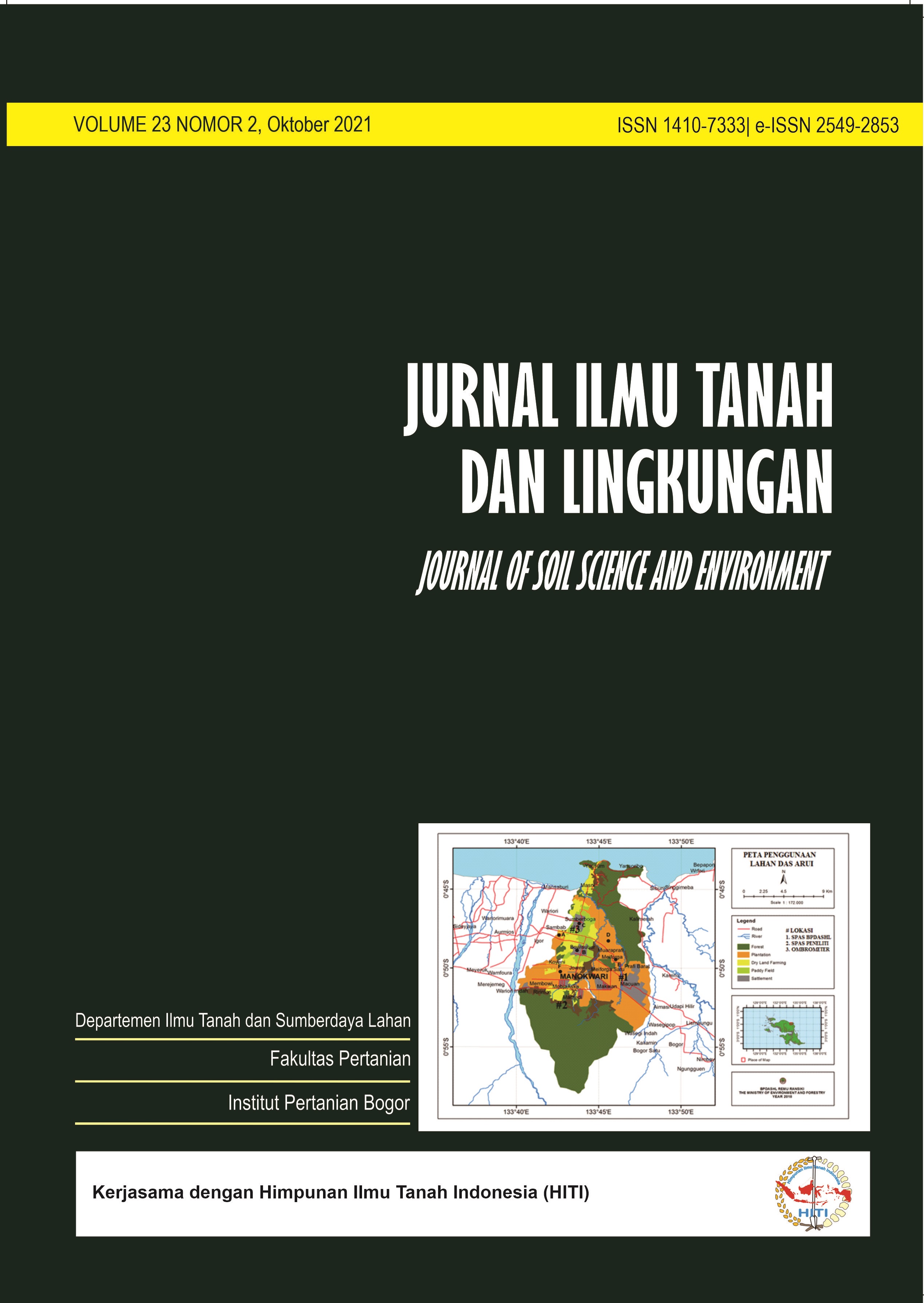Application of Mycorrhizal Biofertilizer on Shallot (Allium cepa var. aggregatum) Plant on Latosol Dramaga
Aplikasi Pupuk Hayati Mikoriza terhadap Tanaman Bawang Merah (Allium cepa var. aggregatum) pada Latosol Dramaga
Abstract
Mycorrhizal bio-fertilizers can maintain land productivity and are environmentally friendly. This study aims to analyze the effect of mycorrhizal biofertilizer on the growth of shallots (Allium cepa var. Aggregatum) and to determine root infection and its effect on soil N, P, K levels. The experimental design used was a completely randomized design (CRD). The treatment of biological fertilizer testing is carried out based on the Regulation of the Minister of Agriculture No. 70 / Permentan / SR. 140/10/2011, consisting of 6 treatments (AF) as follows: A) control, B) standard fertilizers, C) mycorrhizal biological fertilizers, D) mycorrhizal biological fertilizers + 25% standard fertilizers, E) mycorrhizal biological fertilizers + 50% standard fertilizer, F) mycorrhizal biological fertilizer + 75% standard fertilizer. There were 5 replications so that 30 experimental units were obtained. Mycorrhizal bio-fertilizers can reduce the need for standard fertilizers (PS) to 25% to 50%. The combination of biological fertilizer of 2.5 g / plant with 50% PS produces the best plant height and biomass weight, but economically it is recommended to use 25% PS. The treatment applied to mycorrhizae had a very high root infection value, which was above 75%. The types of spores that were successfully associated were Acaulospora sp., Glomus etunicatum, and Glomus sp. The application of mycorrhizae resulted in an increased response of 14.91% for P-available Latosol, while for K-dd and N-total there was no significant effect.
Downloads
References
Brundertt, M.N., Bougher, B., Dell, T.G., Malayczuk, N. 1996. Working with Mycorrhizas in Forestry and Agricultre. ACIAR Monograph 32. Canberra (AU): Australian Centre for International Agriculture Research.
Clapp, J.P., Fitter, A.H., Merryweather, J.W. 1996. Arbuskular mycorrhizas. Di dalam: Hall GS, Lasserre P, Hawksworth DL, editor. Methods for the Examination of Organismal Diversity in Soils and Sediments. Wallingford (UK): CAB International.
Farzaneh, M., Vierheilig, H., Lossl, A., Kaul, H.P. 2011. Arbuscular mycorrhiza enchances nutrient uptake in chickpea. Plant Soil Environ. 57: 465-470.
Feng, G., Song, Y.C., Li, X.L., Christie, P. 2003. Contribution of arbuscular mycorrhizal fungi to utilization of organic sources of phosphorus by red clover in a calcareous soil. Appl Soil Ecol. 22(1): 139-148.
Galii, U., Meier, M., Brunold, C. 1993. Effect of cadmium on non-mycorrhizal and mycorrhizal fungus (Lassasaria laccata Scop.Ex.Fr) Bk and Br: sulphate reduction, thiols and distribution of the heavy metal. New Phytol. 125(1): 837-843.
Hazra, F., Istiqomah, F.N., Adriani, L. 2020. Efektivitas mikoriza dalam meningkatkan pertumbuhan dan efisiensi pupuk pada tanaman bawang merah (Allium Ascalonicum L.). Prosiding Seminar Nasional PERHORTI 2020. Sinergisme Membangun Kawasan Hortikultura Tangguh dan Menyehatkan. Perhimpunan Hortikultura Indonesia (PERHORTI), 17 November 2020, pp. Hal : 257-264.
Hazra, F., and Novtiar R.P. 2020. Effectiveness of MZ2000 mychorrizal biofertilizer on the growth of Sengon seedlings. Journal of Soil Science and Environment 22(1) : 35-39.
Hazra, F., Gusmaini, dan Wijayanti D. 2019. Aplikasi bakteri endofit dan mikoriza terhadap kandungan unsur N, P, dan K pada pembibitan tanaman Lada. Jurnal Ilmu Tanah dan Lingkungan 21(1) : 42-50.
Kurniawati, P. 2011. Pengaruh pemberian inokulum mikoriza dn pemupukan NPK terhadap pertumbuhan semai longkida (Nauclea orientalis L.) pada kondisi tergenang dan tidak tergenang[skripsi]. Bogor (ID): Institut Pertanian Bogor.
Mohamed, A.A., Eweda, W.E.E., Heggo, A.M., Hassan, E.A. 2014. Effect of dual inoculation with arbuscular mycorrhizal fungi and sulphur-oxidising bacteria on onion (Allium cepa L.) and maize (Zea mays L.) grown in sandy soil under green house conditions. J. Annals of Agricultural Science 59(1): 109-118.
Musafa, M.K., Aini, L.Q., Prasetya, B. 2015. Peran mikoriza arbuskula dan bakteri pseudomonas fluorescens dalam meningkatkan serapan P dan pertumbuhan tanaman jagung pada Andisol. J. Tanah dan Sumberdaya Lahan. 2(2): 191-197.
Musfal. 2008. Efektifitas cendawan mikoriza arbuskular (CMA) terhadap pemberian pupuk spesifik lokasi tanaman jagung pada tanah Inceptisol[Tesis]. Medan: Sekolah Pasca Sarjana USU.
Novtiar, R.P. 2019. Aplikasi pupuk hayati mikoriza pada semai sengon buto (Enterolobium cyclocarpum Griseb.)[skripsi]. Bogor (ID): Institut Pertanian Bogor.
Nurmasyitah, Syafruddin, Sayuthi, M. 2013. Pengaruh jenis tanah dan dosis fungi mikoriza arbuskular pada tanaman kedelai terhadap sifat kimia tanah. J. Agrista. 17(3): 103-110.
Permentan. 2011. Pupuk Organik, Pupuk Hayati, dan Pembenah Tanah. Peraturan Menteri Pertanian No. 70/ Permentan/ SR. 140/10/2011.
Rajapakse, S., Miller, J.C. 1992. 15 Methods for studying vesicular-arbuscular mycorrhizal root colonization and related root physical properties. Methode In Microbiology. (24) lo: 301-316.
Rini, M.A., Safitri, N., Bakrie, A.H. 2019. Penggunaan berbagai jenis dan dosis fungi mikoriza arbuskula untuk meningkatkan pertumbuhan vegetatif tanaman tomat. Hal 307-314. Dalam H. Susanti, D.E. Adriani, R.I. Septiani, D. Pebriani, H. Saputra (eds.). Prosiding Seminar Nasional Perhimpunan Hortikultura Indonesia 2019. Hortikultura Berkontribusi Menyehatkan Bangsa. Banjarmasin, 21-22 Agustus 2019
Setiadi, Y. 1991. Aplikasi N Mutu Bidang Pertanian. Jakarta (ID): Direktorat Perguruan Tinggi Swasta, Direktorat Jendral Pendidikan Tinggi Swasta.
Sugiartini, E., Mayasari, K., Ikrarwati. 2016. Petunjuk Teknis Budidaya Bawang Merah di Lahan dan di dalam Pot atau Polybag. Jakarta (ID): Balai Pengkajian Teknologi Pertanian (BPTP) Jakarta.
Sumiati, E., Gunawan, O.S. 2006. Aplikasi pupuk hayati mikoriza untuk meningkatkan efisiensi serapan unsur hara NPK serta pengaruhnya terhadap hasil dan kualitas umbi bawang merah. J. Hort. 17(1): 34-42.
Department of Soil Science and Land Resources Departemen Ilmu Tanah dan Sumberdaya Lahan, Faculty of Agriculture Fakultas Pertanian, IPB University



















